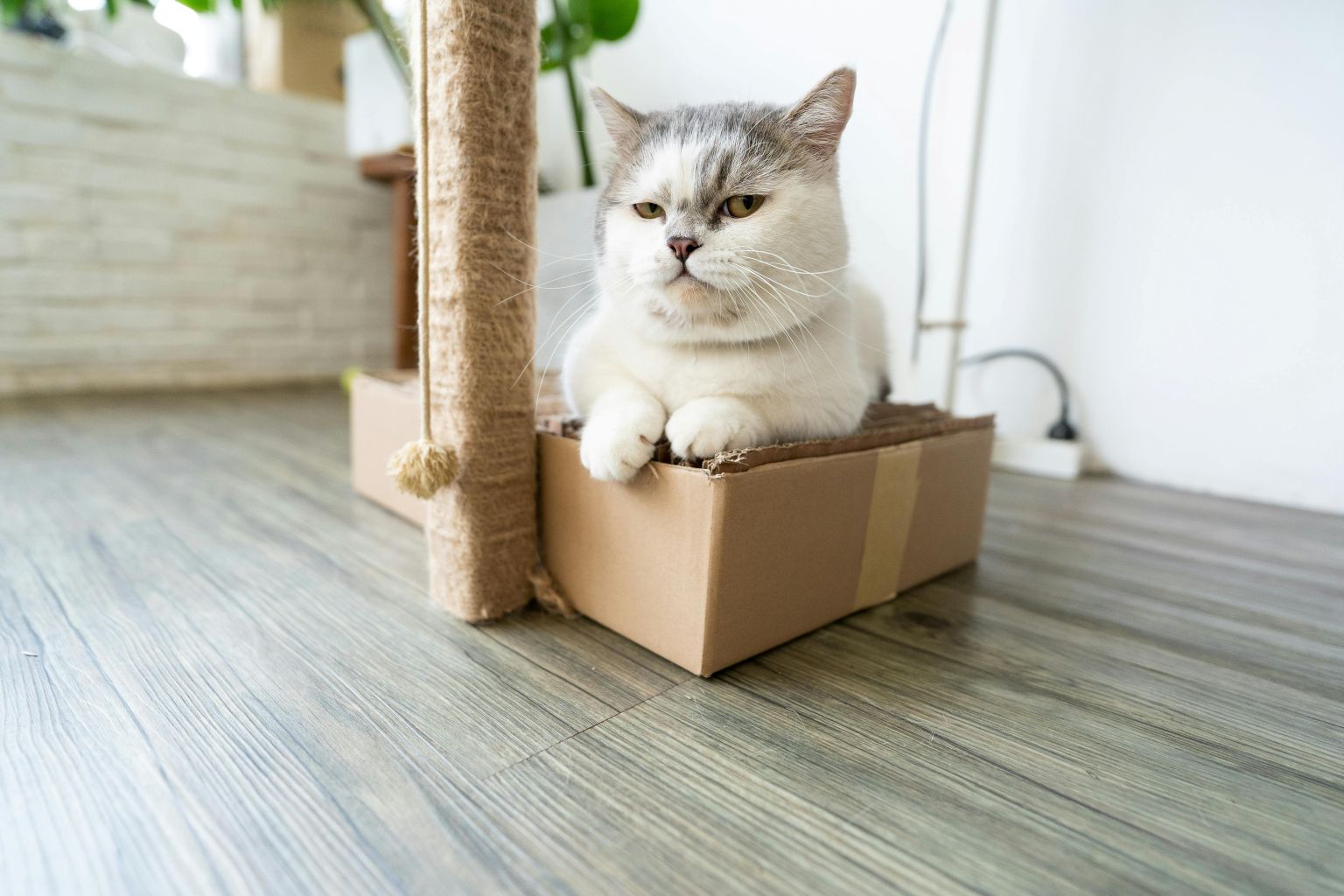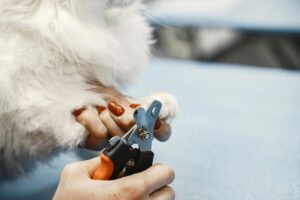Nothing tests a cat lover’s patience quite like coming home to shredded couches and claw-marked curtains. But before you resign yourself to a life of duct-taped furniture, know this: Cats can be trained to redirect their scratching instincts with a little patience and persistence. The secret? Understanding why they scratch, providing better alternatives, and a little strategic deterrence. Read on to learn how to stop cats from scratching furniture and carpets while ensuring they’re happy, healthy, and harmlessly engaged.
Why Do Cats Scratch?
Before you start training your cat to leave your furniture alone, it’s important to understand the importance of scratching and why exactly they do it. Know that scratching is a totally normal behavior for our feline friends and it actually has a lot of benefits. We’ve outlined some of the most common reasons for scratching below.
Marking Territory
Cats are territorial creatures at heart and evolved to make sure other cats know they’re around. When they scratch a surface, scent glands between their paw pads release pheromones that, along with the claw marks, tell feline competitors to stay away.
Claw Health
Scratching is a great way to maintain strong claws a cat can feel proud of. Have you ever found the outer sheath of your cat’s claws lying around the house and wondered how they got there? There’s a high chance they came off when scratching! Removing the sheath allows claws to stay fresh and healthy.
Strong Muscles
Clawing a rough surface is a fantastic exercise for cats to keep their upper body strong. It’s also a full-body stretch that keeps them flexible and nimble.
Stress & Anxiety
Excessive, compulsive scratching can be a sign of stress in cats. Other signs can include aggression toward other cats or you, lowered appetite, frequent meowing, and constant hiding.
Our Tips on How to Keep Cats From Scratching Furniture
Whether your cat is a casual scratcher or a full-blown furniture destroyer, these expert tips will help you protect your home and keep your kitty content. From must-have scratchers to clever deterrents, we cover all the bases. Read on to learn more.
Give Your Cat Something Better to Scratch

Getting scratching objects for your cat is the most important step when trying to stop your cat from scratching furniture. You may have already purchased a scratching post or pad for your fur baby without luck, but don’t give up! They just need a little encouragement to use their new toy.
Placement
Location is everything when it comes to scratching objects. Placing their scratcher in a high-traffic area (like near their favorite nap spot or by the living room sofa) makes it way more tempting than your furniture. Avoid tucking it away in a forgotten corner; your cat wants to scratch where the action is. If your kitty’s already claimed your couch arm as their personal scratching zone, put the post right next to it to gently redirect their habit.
Material
Just like your cat turns up their nose at certain foods, they’ll definitely have opinions about scratching surfaces. One of the keys to discovering how to keep cats from clawing furniture is matching the material to your feline’s natural preferences.
Sisal rope is the gold standard for most cats, with its rough, fibrous texture that mimics tree bark. Cardboard scratchers satisfy those who love to shred, while providing an affordable, replaceable option. For cats who can’t resist your carpet, try a carpet-covered post—just opt for a low-pile, loop-free version to avoid snagged claws. And if your wood furniture or doors are under attack, look for wood or log-style scratchers to appeal to those “outdoor instincts” without sacrificing your coffee table.
Rewards
Cats learn best through positive reinforcement, so the key is to immediately celebrate when they use their scratcher. Keep their favorite treats nearby and toss one over every time they dig in. Even enthusiastic verbal praise in a happy, high-pitched tone (“Good kitty!”) reinforces the behavior.
For play-driven cats, incorporate interactive toys like wand feathers around the base of the scratcher, turning it into a fun game with built-in rewards. Refresh their interest weekly by sprinkling catnip or silvervine on the post, making it irresistibly appealing.
Make Your Furniture Less Appealing to Scratch
With a few clever tweaks, you can make your furniture far less tempting while still keeping your feline friend happy. Start by covering favorite scratching spots with double-sided tape or sticky furniture strips. Cats hate the tacky feeling on their paws.
When figuring out how to keep a cat from scratching the couch specifically, try covering it in tightly woven throws or plastic protectors that slip over arms and corners. A spritz of citrus-scented spray (cats’ least favorite smell!) can also work wonders. Just test it on a hidden spot first to ensure it doesn’t stain your fabric.
Move Your Furniture
Sometimes the simplest solution to keep cats from scratching furniture is to rethink your room layout! By strategically positioning your furniture, you can make those tempting scratching spots far less accessible to your determined feline. Start by pushing sofas and chairs against walls to make the backs difficult to reach. If your cat loves attacking the side of your bed, try placing a bulky storage ottoman or console table as a physical barrier. For cats who scale bookcases to reach the curtains, consider rearranging shelves to break up their climbing path.
 Trim Your Cat’s Claws
Trim Your Cat’s Claws
Regular claw maintenance is your secret weapon for minimizing furniture damage. And it’s easier than you think when you make it routine. Aim to trim your cat’s claws every 2-3 weeks using sharp clippers specifically designed for cats (never human nail tools!).
The trick? Focus only on the clear hook-like tip, avoiding the pink “quick” where nerves and blood vessels live. If your cat’s new to manicures, start by getting them comfortable with paw handling. Gently massage their toes during cuddle sessions, then gradually introduce the clippers over several days. Treats can also be really helpful to distract them and teach them to associate nail trims with good things.
Reduce Stress and Anxiety
When learning how to deter cats from scratching furniture it’s important to rule out stress and anxiety as a factor. By creating a calm environment, you can address the root cause of many scratching issues. Start with vertical territory: Cat trees and wall shelves give anxious felines safe spaces to observe their domain. Add pheromone diffusers (like Feliway) to mimic natural calming scents, especially in multi-cat households where tension runs high. And be sure to keep routines predictable. Feed your cat at the same times daily and give them lots of attention and playtime.
What to Avoid When Teaching Your Cat to Stop Clawing at Furniture
Now that we’ve gone over what to protect your couch from your cat, let’s take a look at everything you shouldn’t do!
Declawing
Declawing is a painful amputation equivalent to removing human fingers at the first knuckle. This outdated procedure involves cutting through bone, tendons, and nerves to remove the entire claw structure, often leading to lifelong physical and behavioral consequences. Cats may develop chronic pain (like arthritis or back problems), litter box avoidance (from paw sensitivity), or increased biting (their natural defense is now gone).
Beyond the physical toll, declawing robs cats of their natural behaviors. Stretching, climbing, and proper scratching are essential for their physical and mental wellbeing. Many vets now refuse to perform the surgery, and it’s banned in several countries and U.S. cities for good reason. With patience and the right scratching solutions (like the ones we’ve covered!), you can protect your furniture without compromising your cat’s health.
Punishment
It’s frustrating to find your favorite chair clawed to shreds, but punishing your cat for scratching is like putting a Band-Aid on a broken leg. It doesn’t fix the problem and often makes things worse.
Cats don’t understand discipline the way humans do. When you yell, spray water, or scold them after the fact, they won’t connect the punishment to the scratching. They’ll just learn to be afraid of you. This can lead to stress-related behaviors like hiding, avoiding the litter box, or even scratching more as a coping mechanism.

